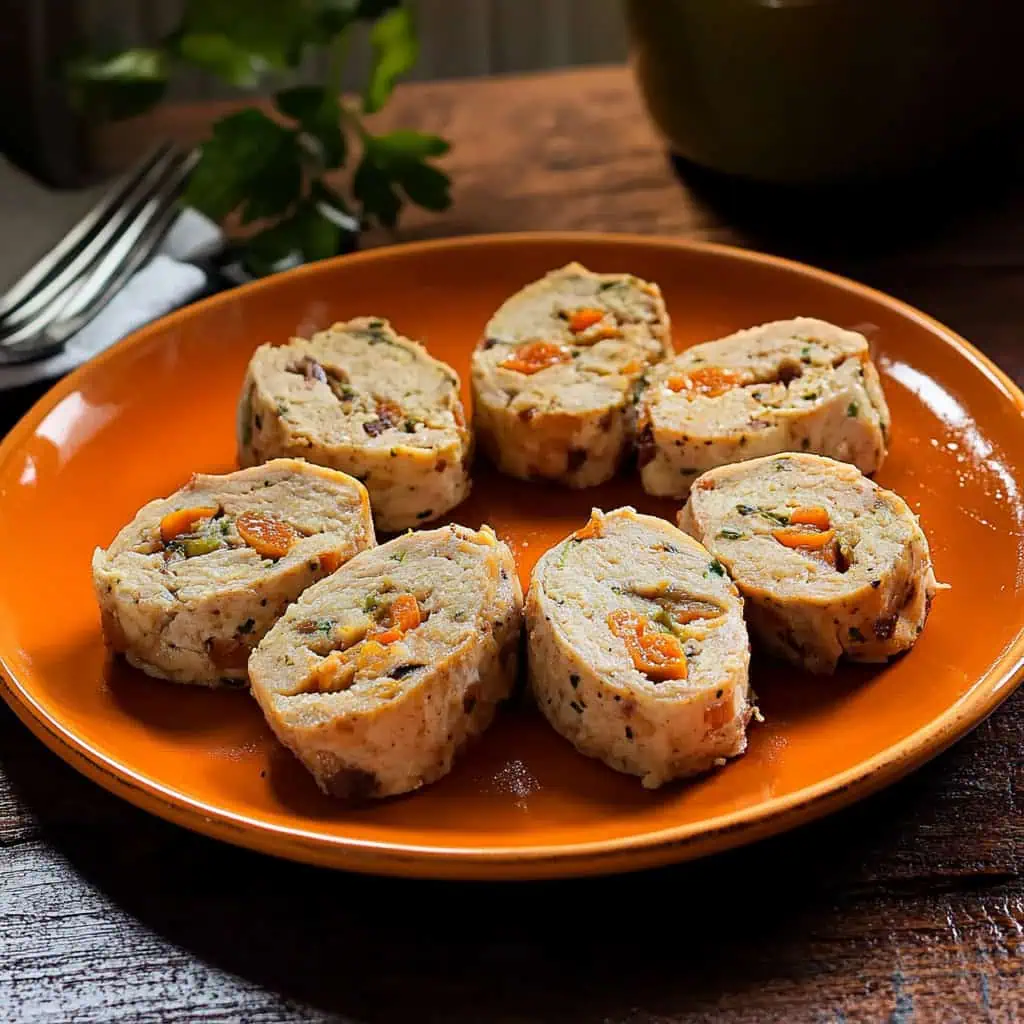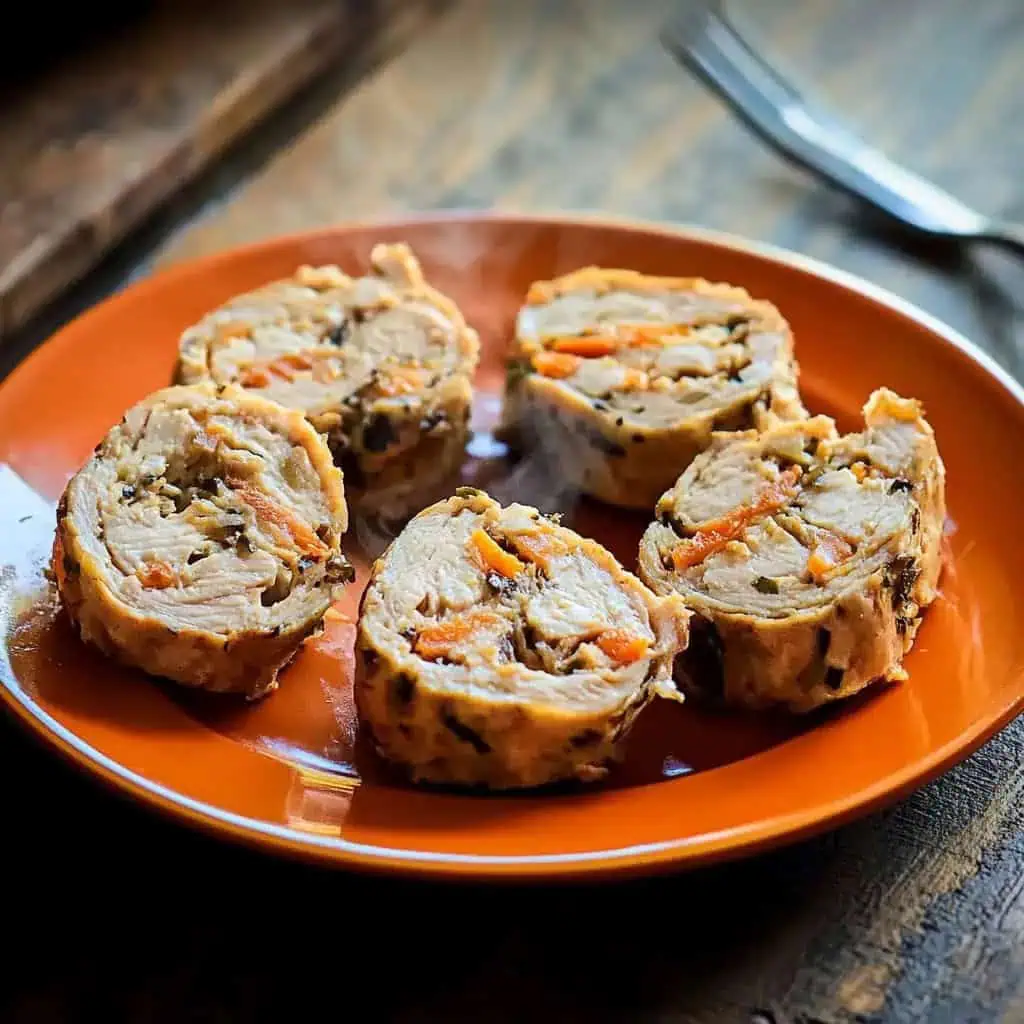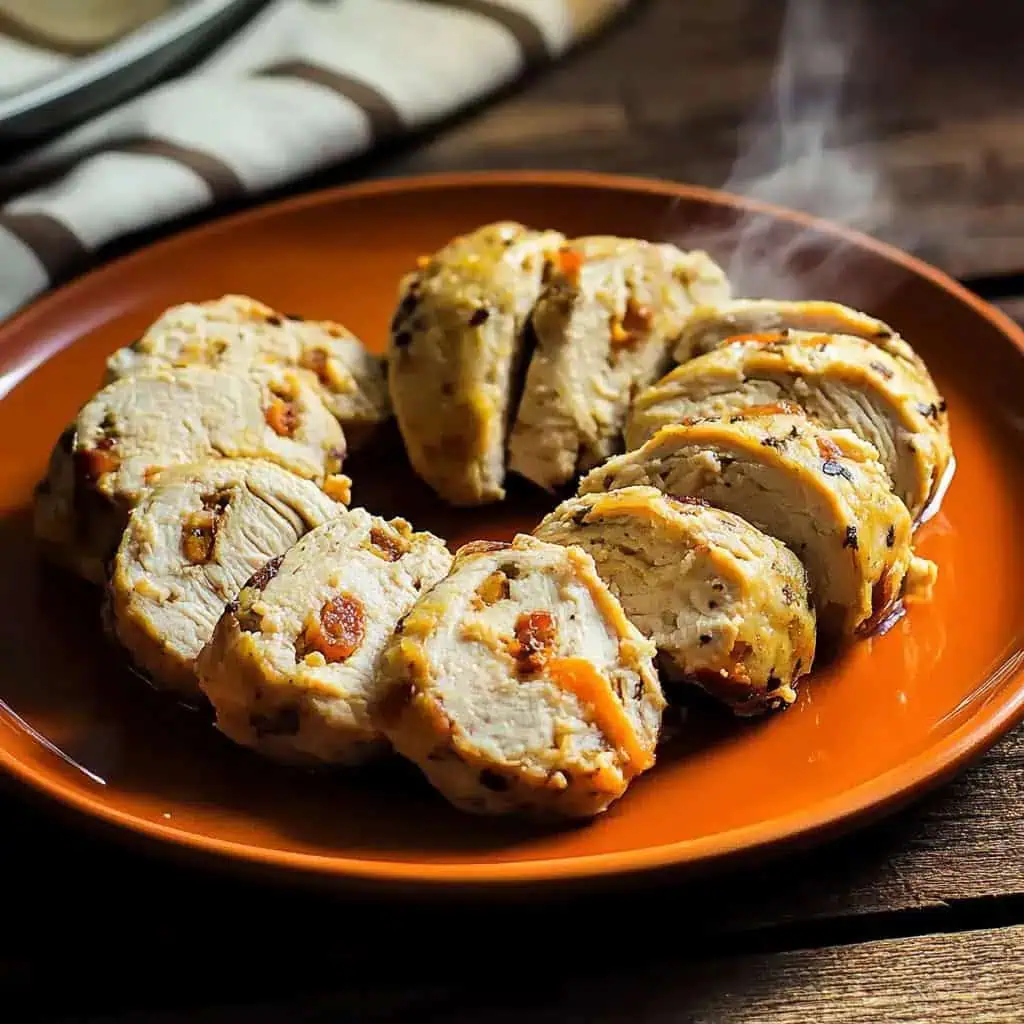Looking for a guilt-free version of everyone's favorite Filipino party dish? This Chicken Embutido is about to become your new best friend in the kitchen. I've swapped out the traditional pork for lean chicken breast, cutting down on the fat while keeping all the festive flavors you know and love. It's the same delicious medley of sweet raisins, savory cheese and colorful veggies, just wrapped up in a lighter package.
What makes this version special is that you're getting about 40% less fat than the pork version, but your guests won't even notice the difference. It's still that same showstopping dish that Filipinos love bringing to parties and potlucks, just a bit kinder to your waistline. This chicken embutido brings all the comfort and nostalgia of the classic recipe with a modern, healthier twist.
Jump to:

Why You'll Love This Recipe
- Healthier alternative to traditional pork embutido
- Perfect make-ahead dish for special occasions
- Versatile - can be served hot or cold
- Budget-friendly yet festive
- Freezer-friendly for meal prep
- Kid-friendly with hidden vegetables
Ingredients
Each ingredient in this recipe serves a special purpose. The ground chicken provides a lean protein base, while vegetables add color, nutrition, and texture. Raisins bring natural sweetness, cheese adds richness, and pickle relish contributes a tangy contrast.
The egg and breadcrumbs work as binders to hold everything together, while garlic, onion, and spices build a savory foundation.
This carefully balanced combination creates the signature sweet-savory flavor profile that makes embutido a beloved Filipino celebration dish.

- 750 g boneless skinless chicken breast, finely ground
- 1 small red bell pepper, finely chopped
- 1 small carrot, finely chopped
- ½ cup raisins
- ½ cup grated cheddar cheese
- ½ cup bread crumbs
- 3 tablespoons pickle relish
- 1 large egg, lightly beaten
- 3 tablespoons tomato ketchup
- ½ teaspoon ground white pepper
- 1 teaspoon salt
- 1 small white onion, finely chopped
- 2 cloves garlic, minced
Equipment
- Food processor or meat grinder: For mincing chicken to achieve the right consistency. If you don't have either, ask your butcher to grind the chicken for you, or you can finely chop it with a sharp knife, though this takes more time.
- Steamer: A traditional bamboo or metal steamer works best. The steaming process is essential for giving embutido its unique texture.
- Mixing bowls: Large bowls allow for easy mixing of all ingredients without spillage.
- Heavy-duty aluminum foil: For wrapping the embutido. The foil needs to be sturdy enough to hold the shape while steaming.
- Sharp knife: For chopping ingredients finely. A sharp knife ensures uniform pieces.
- Cutting board: A separate cutting board for meat is recommended for food safety.
- Measuring cups and spoons: For precise ingredient portions to ensure the perfect balance of flavors.
- Kitchen thermometer (optional): To ensure the chicken is properly cooked to 165°F (74°C).

How To Make
- Start by letting all your ingredients come to room temperature. While waiting, set up your steamer with water and heat it over medium heat.
- Mix the ground chicken breast, salt, and white pepper in a large bowl. Add the minced garlic and chopped onion, mixing everything well with your hands. Work the meat mixture until it starts to become sticky.
- Break the egg into your meat mixture and add the breadcrumbs. Mix these in thoroughly - this helps bind everything together. Now add your carrots, bell peppers, raisins, pickle relish, and grated cheese. Pour in the ketchup and mix until all ingredients are evenly spread throughout the meat.
- Lay out a piece of aluminum foil (about 12x12 inches) on your counter. Take one-third of your mixture and place it in the center. Shape it into a log, about 8 inches long. Roll the foil around the meat tightly and twist both ends to seal. Do this two more times with the remaining mixture to make three logs.
- Place your wrapped logs in the steamer, making sure they're not touching each other. Steam for 45 minutes over medium heat. Keep an eye on the water level - if it gets low, carefully add more hot water.
- After cooking, let the logs rest for 5-10 minutes before unwrapping. Slice into rounds about 1-inch thick. If you like, you can pan-fry the slices until golden brown for extra flavor.
- Serve with banana ketchup or sweet chili sauce on the side. If you have leftovers, let them cool completely before storing them in the refrigerator.
Remember: You'll know your embutido is done when the internal temperature reaches 165°F (74°C), or when a knife inserted into the center comes out clean.

Tips from Lola's Kitchen
- Grind the chicken twice for better texture and more even cooking.
- Chill the mixture for 30 minutes before wrapping for easier handling. The cold mixture is less sticky and forms better logs.
- Test-cook a small portion to check seasoning before wrapping all your embutido. This allows you to adjust the flavor to your preference.
- Double-wrap in foil to prevent water seepage during steaming. This keeps your embutido moist but not soggy.
- Place a coin in the steamer water - when it stops rattling, you need to add more water. This traditional Filipino trick ensures you never run out of steam!
- Wet your hands with a little water or oil when shaping the logs to prevent sticking.
- Let the embutido cool completely before slicing for cleaner, more attractive pieces.
- Serve at room temperature for the best flavor profile. The flavors develop and meld together better.
Substitutions
- Chicken: Ground turkey works wonderfully as a 1:1 replacement. If you prefer to use pork, use lean ground pork in the same quantity.
- Bell peppers: Pimientos or roasted capsicum offer a sweeter, less crunchy alternative.
- Breadcrumbs: Ground crackers, crushed cornflakes, or rolled oats can be substituted in the same amount.
- Raisins: Chopped dates, dried cranberries, or even chopped prunes can provide a similar sweet element.
- Cheddar cheese: Queso de bola (Edam), processed cheese, or any melting cheese you prefer works well.
- Egg: For an egg-free version, try 3 tablespoons of mashed potato as a binder.
- Pickle relish: Finely chopped olives or capers can provide a similar tangy bite.
Troubleshooting
- If too dry: Add 1-2 tablespoons of milk to the mixture to increase moisture without affecting the flavor.
- If too wet: Add more breadcrumbs gradually, about a tablespoon at a time, until you reach the right consistency.
- If falling apart when sliced: Your embutido might need more binding. Add another egg or let it cool completely in the refrigerator before slicing.
- If bland: Adjust seasoning before wrapping. Don't be afraid to add more salt or even a splash of soy sauce for depth of flavor.
- If the center is still pink: Continue steaming for another 10-15 minutes. Always check with a thermometer if unsure.
- If the foil tears during steaming: Double-wrap next time, and be careful not to fill the foil too much. Leave room for expansion.
Storage & Reheating
- Refrigerator: Store in an airtight container for up to 5 days. Wrap tightly in plastic wrap to prevent drying out.
- Freezer: Wrap individual logs or slices in plastic wrap, then aluminum foil, and freeze for up to 3 months. Label with the date.
- Thawing: Thaw overnight in the refrigerator for best texture and safety.
- Reheating:
- Steam for 5-10 minutes to maintain moisture
- Pan-fry slices in a little oil until golden and heated through
- Microwave on medium power with a damp paper towel covering to prevent drying
- Best served at room temperature or slightly warm rather than piping hot to appreciate all the flavors.

FAQ
Can I make this ahead for a party?
Yes, you can prepare chicken embutido up to 2 days in advance. Store it in the refrigerator, and either serve cold or reheat before serving.
Why is my embutido breaking apart when I slice it?
This usually happens when there isn't enough binding. Ensure you're using enough egg and breadcrumbs, and that the mixture is well-combined. Also, make sure it's completely cooled before slicing.
Can I air fry the slices instead of pan-frying?
Absolutely! Air fry at 350°F (180°C) for about 5 minutes per side until golden and heated through. This gives a nice crispy exterior.
How do I know if my embutido is fully cooked?
The internal temperature should reach 165°F (74°C). Alternatively, insert a knife into the center - it should come out clean with no pink meat visible.
Can I skip the steaming and bake it instead?
Steaming is traditional and ensures the proper moist texture. If you must bake, do so in a water bath at 350°F (180°C) for about 60 minutes, covered with foil.
Is there a way to make this recipe lower in calories?
Use low-fat cheese, increase the vegetables, and decrease the raisins slightly. You can also use egg whites instead of whole eggs.
Can I add boiled eggs in the center like traditional embutido?
Yes! Hard-boil some eggs, peel them, and place them in the center of your meat mixture before wrapping in foil.
Why do I need to let the ingredients come to room temperature?
Room temperature ingredients mix more evenly and cook more uniformly, resulting in better texture and flavor.
Related
Looking for other recipes like this? Try these:

Chicken Embutido
Equipment
- Food processor or meat grinder (panggiling) for mincing chicken
- Steamer traditional bamboo or metal steamer works best
- Mixing bowls (mangkok) for combining ingredients
- Heavy-duty aluminum foil for wrapping
- Sharp knife (kutsilyo) for chopping ingredients
- Cutting board (Sangkalan) for preparation
- Measuring cups and spoons (Panukat) for precise ingredients portions
- Kitchen thermometer (optional) to ensure proper cooking temperature
Ingredients
- 750 g boneless skinless chicken breast (dibdib ng manok), finely ground
- 1 small red bell pepper pulang siling pangsigang, finely chopped
- 1 small carrot karot, finely chopped
- ½ cup raisins pasas
- ½ cup grated cheddar cheese kinayod na keso
- ½ cup bread crumbs
- 3 tablespoon pickle relish
- 1 large egg itlog, lightly beaten
- 3 tablespoon tomato ketchup
- ½ teaspoon ground white pepper dinurog na puting paminta
- 1 teaspoon salt asin
- 1 small white onion sibuyas, finely chopped
- 2 cloves garlic bawang, minced
Instructions
- Start by letting all your ingredients come to room temperature. While waiting, set up your steamer with water and heat it over medium heat.
- Mix the ground chicken breast, salt, and white pepper in a large bowl. Add the minced garlic and chopped onion, mixing everything well with your hands. Work the meat mixture until it starts to become sticky.
- Break the egg into your meat mixture and add the breadcrumbs. Mix these in thoroughly - this helps bind everything together. Now add your carrots, bell peppers, raisins, pickle relish, and grated cheese. Pour in the ketchup and mix until all ingredients are evenly spread throughout the meat.
- Lay out a piece of aluminum foil (about 12x12 inches) on your counter. Take one-third of your mixture and place it in the center. Shape it into a log, about 8 inches long. Roll the foil around the meat tightly and twist both ends to seal. Do this two more times with the remaining mixture to make three logs.
- Place your wrapped logs in the steamer, making sure they're not touching each other. Steam for 45 minutes over medium heat. Keep an eye on the water level - if it gets low, carefully add more hot water.
- After cooking, let the logs rest for 5-10 minutes before unwrapping. Slice into rounds about 1-inch thick. If you like, you can pan-fry the slices until golden brown for extra flavor.
- Serve with banana ketchup or sweet chili sauce on the side. If you have leftovers, let them cool completely before storing them in the refrigerator.
- Remember: You'll know your embutido is done when the internal temperature reaches 165°F (74°C), or when a knife inserted into the center comes out clean.
Tips from Lola's Kitchen
- Grind the chicken twice for better texture
- Chill the mixture for 30 minutes before wrapping for easier handling
- Test-cook a small portion to check seasoning
- Double-wrap in foil to prevent water seepage
- Place a coin in the steamer water - when it stops rattling, you need to add more water
Nutrition
The Story Behind Chicken Embutido
Like many beloved Filipino dishes, embutido has its roots in Spanish colonial times, when European culinary traditions began to blend with local Filipino flavors. The word "embutido" itself comes from the Spanish term for sausage, but our Filipino version took an interesting turn from its European ancestor. While Spanish embutido is a traditional cured meat sausage, Filipino cooks cleverly adapted the recipe to create something uniquely their own – a steamed meat roll that became a staple at every celebration.
The evolution of chicken embutido marks a modern chapter in this dish's rich history. As health consciousness grew in Filipino communities, innovative home cooks began experimenting with leaner alternatives to the traditional pork version. Chicken embutido emerged as a healthier variation that quickly gained popularity, especially among health-conscious families who didn't want to give up the beloved flavors of this festive dish.
What makes Filipino embutido truly special is its versatility. Unlike Western meatloaves that typically stick to a standard recipe, our version embraces a delightful mix of textures and flavors – from sweet raisins to savory cheese, crunchy vegetables to tangy pickle relish. This combination might seem unusual to outsiders, but it perfectly represents the Filipino palate's love for contrasting flavors in a single dish.
The preparation method itself tells a story of Filipino ingenuity. Instead of using traditional sausage casings, our ancestors discovered that aluminum foil could create the perfect cylindrical shape when steamed. This practical solution not only made the dish easier to prepare at home but also gave birth to the distinctive presentation we know today – neat slices revealing a colorful mosaic of ingredients that make every bite interesting.
Today, chicken embutido has earned its place not just as a healthier alternative, but as a beloved dish in its own right. You'll find it at Christmas gatherings, birthday celebrations, and even in modern Filipino food businesses that cater to health-conscious customers. It's a testament to how Filipino cuisine continues to evolve while maintaining its deep connections to family, celebration, and the joy of sharing good food.
Whether served hot from the steamer, pan-fried until golden, or cold as a sandwich filling, chicken embutido represents the best of Filipino food innovation – taking a traditional recipe and making it healthier without sacrificing the flavors that make it special. It's comfort food that you can feel good about sharing with your loved ones, proving that healthy eating doesn't mean giving up the dishes that bring us together.










Comments
No Comments